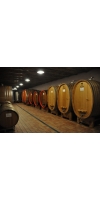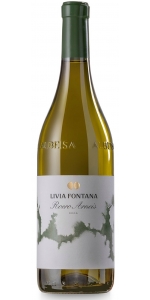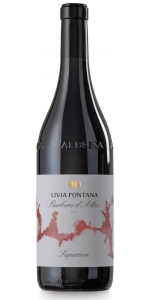Wine from Livia Fontana

Livia inherited the passion for viticulture from her father Ettore and she in her turn transmits with love and enthusiasm the values of those who preceded her in these vineyards. After more than two hundred years, the blood and fiber of the company are still united and today carried forward by the eighth generation while maintaining the history of the family’s objectives made with seriousness, commitment and love of the earth.
The Livia Fontana winery is a rare case in which business and family blend together blurring the boundaries of both, becoming an example of how the convergence of objectives makes the family united and the company successful. The winery is managed by Livia Fontana and her two sons, Michele and Lorenzo, who have been preceded by seven generations of the Fontana family. Each with their own roles brings energy, enthusiasm, competence and passion. The result is excellent wines that are appreciated throughout the world for the way in which tradition and new technologies merge in products of very high quality.
Livia Fontana Roero Arneis is made from 100 percent Arneis.
Straw-yellow color with green highlights. Delicate, fresh and floral bouquet, rich in peach and apple flavor. Well balanced with little acidity.The wine is produced in Priocca and Castagnito, about a 2-hectare vineyard located at 250-350 m a.s.l.Organoleptic characteristics: straw-yellow color with green highlights. Delicate, fresh and floral bouquet, rich in peach and apple flavor. Well balanced with acidity.
Classic accompaniment to fish and seafood as well as any kind of starter. Excellent also with first courses or as an aperitif.
Livia Fontana Barbera d'Alba Superiore is made from 100 percent Barbera.
Organoleptic characteristics: intense ruby red color. Fresh and intense aromas with currants and berries notes. Warm, full, rich and persistent taste, full body. Suitable for long aging.
Excellent accompaniment to warm appetizers, rich first courses, red meat and the medium-seasoned cheeses.
Livia Fontana Barbera d'Alba Superiore is made from 100 percent Barbera.
Organoleptic characteristics: intense ruby red color. Fresh and intense aromas with currants and berries notes. Warm, full, rich and persistent taste, full body. Suitable for long aging.
Excellent accompaniment to warm appetizers, rich first courses, red meat and the medium-seasoned cheeses.
- back
Selected Options
Wineries
Categories
Pricing
Countries
Regions
Grape Types
Wineries
Organic/Free Shipping
Justin Vineyards & Winery Isosceles Reserve is made from 86% Cabernet Sauvignon, 6% Merlot, 4% Cabernet Franc, 3% Malbec and 1% Petit Verdot
Dark, ruby/purple core with a medium intensity rim and moderately stained tears. Complex and very aromatic with black cherry, cassis, toasty vanilla, cinnamon, cedar, graphite, oak, dusty leaf notes, star anise and red licorice. Full bodied, with ripe black fruit of cherry, currant and berry with baking spice on entry. The mid-palate features sustained fruit with sweet tobacco, leather, vanilla and licorice, and mouth coating tannins that balance its full fruit character through a very long, fresh and beautifully balanced finish that evolves with a complex mix of fruit, spice and savory elements.
The 2016 ISOSCELES Reserve is a bold, but balanced wine that pairs nicely with rich meat dishes like slow cooked stews and braises, but shines beautifully with a simple grilled ribeye steak.
Review:
Clean lines of blackberry jam, charred toast and crushed slate make for a focused nose in this reserve blend of 86% Cabernet Sauvignon, 6% Merlot, 4% Cabernet Franc, 3% Malbec and 1% Petit Verdot. It is very dense and thick on the palate, where mocha, caramel, loamy earth and dark berry flavors align into an lusciously rich yet elegantly dry experience.
-Wine Enthusiast 95 Points
DuMOL 'Chloe' Chardonnay is made from 100 percent Chardonnay.
Winemaker’s Notes
Our first vintage of Chloe was 2000, and although the vineyard mix has changed over the years, the wine has always focused on the central Russian River Valley district to represent the richest side of DuMOL Chardonnay. The wine has lower acidity than our coastal wines, making it more approachable in its youth, and the flavors focus more on orchard fruits than citrus. The neighboring El Diablo and Flora Marie vineyards sit overlooking the river on gravelly loam soils and provide the wine's deep fruit generosity. These are the first vineyards we harvest each year as the lean soils really advance their crop’s ripening. We offset this fruit richness with grapes from our Green Valley Bressay Estate, which overflow with tense structure and coastal acidity. It’s a seamless combination that produces a thrilling result, and Chloe is the first of our designate Chardonnays you should open each vintage.
The wine’s aromas and flavors are akin to peach, apricot, oatmeal and anise. Fresh thyme and honey notes combine with tangerine and lemon curd. It’s a deeply textural and expansive wine that gently glides along the palate. Lively acidity and spicy notes of ginger and white pepper provide lift and energy to the finish. A beautiful, layered, and richer style to enjoy soon after release. Drink between late-2024 and 2029 and serve no cooler than 55º F.
Review:
A Central Russian River Blend, the 2022 Chardonnay Chloe is a bright yellow hue and captures a wide spectrum of citrus with notes of orange, Meyer lemon, fresh pineapple, toasted spice, and a hint of almond through the mid-palate as well as a nice lift of citrus on the finish. It’s a beautiful wine offering a richer tone through the range. Drink 2024-2034.
-Jeb Dunnuck 96 Points






